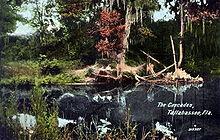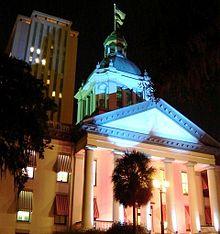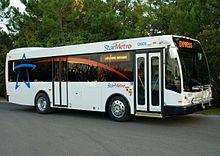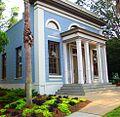Tallahassee, Florida Blood Testing Facilities
 Represents a LabCorp blood testing facility
Represents a LabCorp blood testing facility Represents a Quest Diagnostics blood testing facility
Represents a Quest Diagnostics blood testing facility

Nearby Labcorp Blood Testing facilities:
- Labcorp Center Distance: 1 m, 545 John Knox Rd Ste 103, Tallahassee, Leon County, FL, 32303
- Labcorp Center Distance: 3 m, 2477 Tim Gamble Pl Ste 102, Tallahassee, Leon County, FL, 32308
- Labcorp Center Distance: 51 m, 201 E Marion St, Madison, Madison County, FL, 32340
- Labcorp Center Distance: 66 m, 247 Northside Dr Suite A, Valdosta, Lowndes County, GA, 31602
- Labcorp Center Distance: 79 m, 507 W 3Rd Ave Ste 6B, Albany, Dougherty County, GA, 31701
- Labcorp Center Distance: 83 m, 1034 Ross Clark Cir, Dothan, Houston County, AL, 36303
- Labcorp Center Distance: 84 m, 2402 N Tift Avenue Suite 101, Tifton, Tift County, GA, 31794
- Labcorp Center Distance: 99 m, 265 Sw Malone Street Suite 105, Lake City, Columbia County, FL, 32025
Nearby Quest Blood Testing facilities:
- Quest Center Distance: 2 m, 1605 E. Plaza Drive, Tallahassee, Leon County, FL, 32308-5362
- Quest Center Distance: 5 m, 1594 Capital Cir Nw-1, Tallahassee, Leon County, FL, 32303-3183
- Quest Center Distance: 58 m, 4767 Highway 90, Marianna, Jackson County, FL, 32446-0173
- Quest Center Distance: 66 m, 341 Northside Dr, Valdosta, Lowndes County, GA, 31602-1861
- Quest Center Distance: 75 m, 206 Monument Ave, Port St Joe, Gulf County, FL, 32456-1816
- Quest Center Distance: 77 m, 609 5Th St Sw, Live Oak, Suwannee County, FL, 32064-2239
- Quest Center Distance: 78 m, 1611 Main St, Chipley, Washington County, FL, 32428-5974
- Quest Center Distance: 79 m, 711 N Jefferson St, Albany, Dougherty County, GA, 31701-5118
- Quest Center Distance: 84 m, 625 W Baldwin Blvd, Panama City, Bay County, FL, 32405-3364
- Quest Center Distance: 85 m, 1807 Old Ocilla Rd, Tifton, Tift County, GA, 31794-1617
- Quest Center Distance: 95 m, 289 Sw Stonegate Terrace, Lake City, Columbia County, FL, 32024-3463
Tallahassee Florida Hormone Replacement Therapy Services
21st century medical advances are changing the way that we think about health and aging in the world today. Aging, only decades ago, was thought to be unavoidable and irreversible, but new techniques and scientific discoveries are showing how what we understand is the process of aging is really the combination of a variety of different factors that impede our overall health and vitality. One of the biggest culprits which appear to hasten the downward spiral of aging is Hormone Imbalance.
Hormones are the chemical messengers of the body, and they encourage peak physiological function when they are in a state of Hormone Balance. Human Growth Hormone and Testosterone are two of the hormones that are most in danger of falling out of balance as we grow older, and Low-T and Hypopituitarism both have a seriously detrimental impact on overall vitality and longevity.
The Conscious Evolution Institute is a licensed and board certified provider of Testosterone Replacement Therapy and HGH Deficiency Treatment for patients in and around the Tallahassee area. We can arrange for an appointment with an affiliate in your area that can provide us with all of the pertinent medical data that we need to restore Hormone Balance with Hormone Replacement Therapy! Call us via the number you see at the top of the page or fill out the form on the page to arrange to speak to one of our wonderfully talented and knowledgeable Hormone Specialists!
Human Growth Hormone Clinics in Tallahassee Florida
Healthy HGH Levels are one of the keys to maintaining a healthy body and mind. Human Growth Hormone is responsible for maintaining metabolic sufficiency at the cellular level. This means that healthy Growth Hormone Levels are necessary for your body to work at the best functional capacity. HGH Deficiency impedes the body's ability to function and becomes more likely and more common with age. Beginning around thirty years old, the body, for reasons that we don't yet fully understand, slowly loses its natural ability to secrete HGH. This change is almost imperceptible at first, but eventually can lead to serious medical problems.
Over time and dependent upon other health factors, this can eventually lead to a litany of symptoms long associated with aging, including increased susceptibility to illness, depression, mild cognitive decline, increased bodyfat (especially around the midsection), loss of strength, lack of energy, trouble healing, and more. HGH Injection Therapy can improve health and wellness by mitigating the symptoms of Hypopituitarism with daily subcutaneous HGH Shots.
Tallahassee Florida Sermorelin Injections for HGH Deficiency
There are two primary ways to treat Growth Hormone Imbalance. HGH Shots are fantastic, but they are not the only option on the table. Sermorelin Acetate is another treatment option that we provide to our patients, and it has been clinically proven to be equally effective to Prescription Bio-Identical HGH for the treatment of Age-Related Hypopituitarism. Sermorelin works by stimulating the pituitary to produce its own, real, natural Growth Hormone by imitating the function of GH-RH, a hormone released by the hypothalamus from which Recombinant Sermorelin is directly derived.
Sermorelin is available for off-label prescription and is notable for being a cost-effective HGH Alternative. We'd love to explain the pros and cons of HGH vs. Sermorelin for you in more detail.
Testosterone HRT Prescriptions in Tallahassee Floida
Testosterone represents the epitimome of masculinity. It is responsible for everything that separates a man from a woman. Unfortunately, millions of men nationwide struggle with their vitality as a result of undiagnosed and untreated Low-T. Don't let yourself fall victim to the stigma of Hypogonadism when easy and accessible treatment is available. Testosterone Replacement Therapy is highly effective at restoring sexual appetite and improved sexual function, all while improving your health in other ways as well.
People get caught up regarding the sexual symptoms of Low-T, but most men don't think about the other costs of Testosterone Deficiency and how they can harm your health and impede your well-being. Men with Testosterone Deficiency are more likely to suffer from poor cholesterol and are more likely to suffer from dangerous heart and cardiovascular issues. They are also more likely to be anxious and lack confidence. Furthermore, Low-T is associated with weight gain, lack of energy, frailty, and even increased risk of osteoporosis. If you believe that you may need prescription Testosterone, don't wait another minute. The Conscious Evolution Institute is standing by!
Tallahassee Florida Information
Tallahassee is located in Leon County Florida, and is also the capital of the state. The city is located at the base of the Florida Panhandle, linking Panama City, Pensacola, and other coastal cities to the greater portion of the state. Tallahassee is notable for being the largest city in Florida by land-mass, because the city takes up the majority of the space within the county in which it resides. There are no other cities in Leon County, but unincorporated suburbs of the city are Monticello, Midway, Woodville, Havana, and Crawfordville. Neighborhoods in Tallahassee include Concord, Black Creek, Iamonia, Blocker, and Meridian.
Tallahassee Universities and Education
The city of Tallahassee is also notable for being the home of Florida State University, whose Seminoles are a powerhouse team in both men's basketball and football, representing the Atlantic Coast Conference. The Seminoles were a native American Tribe that once lived in the area in great numbers, and some still reside there today. Unlike many other athletic teams with native American mascots, the Seminoles have an agreement with the tribe to use the namesake for their mascot. Florida A&M is also located in Tallahassee, and is one of the biggest historically black universities in the United States.
Things to Do in Tallahassee Florida
There are lots of interesting museums and landmarks which make Tallahassee a great place to visit. Museums in the city include the Tallahassee Automobile Museum, the FSU Museum of Fine Arts, the Knott House Museum, and the Museum of African American History and Culture. Among the historical landmarks in Tallahassee are Railroad Square, Mission San Luis de Apalachee, and the Florida Governor's Mansion.
All About Tallahassee, Florida Geographic Area



Tallahassee ( /ËutR¦lÉoËnhR¦si/) is the capital of the U.S. state of Florida. It is the county seat and only incorporated municipality in Leon County, and is the 128th largest city in the United States. Tallahassee became the capital of Florida, then the Florida Territory, in 1824. In 2010, the population recorded by the U.S. Census Bureau was 181,376, and the Tallahassee metropolitan area is 367,413.
/ËutR¦lÉoËnhR¦si/) is the capital of the U.S. state of Florida. It is the county seat and only incorporated municipality in Leon County, and is the 128th largest city in the United States. Tallahassee became the capital of Florida, then the Florida Territory, in 1824. In 2010, the population recorded by the U.S. Census Bureau was 181,376, and the Tallahassee metropolitan area is 367,413.
Tallahassee is one of Florida's most prominent college cities, and is home to several colleges and universities, most notably Florida State University and Florida A&M University. Other schools in Tallahassee include Tallahassee Community College and branches of Saint Leo University, Thomas University, Keiser University, Barry University, Flagler College, and Embry-Riddle Aeronautical University.
Tallahassee is a regional center for trade and agriculture in the Florida Panhandle, and is served by Tallahassee Regional Airport. With one of the fastest growing manufacturing and high tech economies in Florida, its major private employers include a General Dynamics Land Systems manufacturing facility (military and combat applications), the Municipal Code Corporation, which specializes in the publication of municipal and county legal references; and a number of national law firms, lobbying organizations, trade associations and professional associations, including the Florida Bar and the Florida Chamber of Commerce. It is recognized as a regional center for scientific research, and is home to the National High Magnetic Field Laboratory, the largest and highest-powered magnet research laboratory in the world.

During the 17th century, several Spanish missions were established in the territory of the Apalachee to procure food and labor for the colony at St. Augustine. The largest of these, Mission San Luis de Apalachee, has been partially reconstructed by the state of Florida.

The name "Tallahassee" is a Muskogean Indian word often translated as "old fields". This likely stems from the Creek (later called Seminole) Indians who migrated from Georgia and Alabama to this region in the late 18th and early 19th centuries. Upon arrival, they found large areas of cleared land previously occupied by the Apalachee tribe. Earlier, the Mississippian Indians built mounds near Lake Jackson around AD 1200, which survive today in the Lake Jackson Archaeological State Park.

The expedition of Panfilo de Narvaez encountered the Apalachees, although it did not reach the site of Tallahassee. Hernando de Soto and his expedition occupied the Apalachee town of Anhaica in what is now Tallahassee in the winter of 1538 ae1539. Based on archaeological excavations, this site is now known to be located about 0.5 miles (800 m) east of the present Florida State Capitol. The DeSoto encampment is believed to be the first place Christmas was celebrated in the continental United States.

Tallahassee was created as the capital of Florida during the second legislative session. It was chosen as it was roughly equidistant from St. Augustine and Pensacola, which had been the capitals of the Spanish colonies of East Florida and West Florida, respectively. The first session of Florida's Legislative Council aeas a territory of the United States aemet on July 22, 1822 at Pensacola and members from St. Augustine traveled fifty-nine days by water to attend. The second session was in St. Augustine and required western delegates to travel perilously around the peninsula on a twenty-eight day trek. During this session, it was decided that future meetings should be held at a half-way point to reduce the distance. Two appointed commissioners selected Tallahassee, at that point an abandoned Apalachee settlement, as a halfway point. In 1824, the third legislative session met there in a crude log capitol.
From 1821 through 1845, the rough-hewn frontier capital gradually grew into a town during Florida's territorial period. The Marquis de Lafayette, French hero of the American Revolution, returned for a grand tour of the United States in 1824. The US Congress voted to give him $200,000 (the same amount he had given the colonies in 1778), US citizenship, and the Lafayette Land Grant, 36 square miles (93 km2) of land that today includes large portions of Tallahassee. In 1845, a Greek revival masonry structure was erected as the Capitol building in time for statehood. Now known as the "old Capitol," it stands in front of the Capitol high rise building, which was constructed in the 1970s.
Tallahassee was the center of the slave trade in Florida as the city was the capital of the Cotton Belt. During the American Civil War, Tallahassee was the only Confederate state capital east of the Mississippi not captured by Union forces. A small engagement, the Battle of Natural Bridge, was fought south of the city on March 6, 1865.
During the 19th century the institutions that would eventually be combined into what is now known as Florida State University were established in Tallahassee, firmly cementing it as a university town. These including the Tallahassee Female Academy (founded 1843) and the Florida Institute (founded 1854). In 1851 the Florida legislature decreed two seminaries to be built on either side of the Suwanee River, East Florida Seminary and West Florida Seminary. In 1855 West Florida Seminary was transferred to the Florida Institute building (which had been established as an inducement for the state to place the seminary in Tallahassee). In 1858 the seminary absorbed the Tallahassee Female Academy and became coeducational.
Following the Civil War, much of Florida's industry moved to the south and east, a trend that continues today. The end of slavery hindered the cotton and tobacco trade, and the state's major industries shifted to citrus, lumber, naval stores, cattle ranching and tourism. The post-Civil War period was also when many former plantations in the Tallahassee area were purchased by wealthy northerners for use as winter hunting preserves. This included the hunting preserve of Henry L. Beadel, who bequeathed his land for the study of the effects of fire on wildlife habitat. Today, the preserve is known as the Tall Timbers Research Station and Land Conservancy, nationally recognized for its research into fire ecology and the use of prescribed burning.

Until World War II, Tallahassee remained a small southern town, with virtually the entire population living within 1 mile (2 km) of the Capitol. The main economic drivers were the universities and state government, where politicians met to discuss spending money on grand public improvement projects to accommodate growth in places such as Miami and Tampa Bay, hundreds of miles away from the capital. By the 1960s, there was a movement to transfer the capital to Orlando, closer geographically to the growing population centers of the state. That motion was defeated, however, and the 1970s saw a long-term commitment by the state to the capital city with construction of the new capitol complex and preservation of the old Florida State Capitol building.
In 1977, a 23-story high-rise Capitol building designed by architect Edward Durell Stone was completed, which is now the third-tallest state capitol building in the U.S. In 1978 the old capitol was scheduled for demolition, but the State Of Florida decided to keep the Old Capitol as a museum and point of interest. The new and old capitols still stand to this day in Tallahassee.

Tallahassee was the center of world attention for six weeks during the 2000 United States Presidential election recount, which involved numerous rulings by the Florida Secretary of State and the Florida Supreme Court.
According to the United States Census Bureau, the city has a total area of 98.2 square miles (254.3 km2), of which, 95.7 square miles (247.9 km2) of it is land and 2.5 square miles (6.5 km2) of it (2.59%) is water.


Tallahassee's terrain is hilly by Florida standards, being located at the southern end of the Red Hills Region, just above the Cody Scarp. The elevation varies from near sea level to just over 200 feet (61 m), with the state capitol located on one of the highest hills in the city. The city also includes two large lake basins, Lake Jackson and Lake Lafayette, and borders the northern end of the Apalachicola National Forest.
The flora and fauna are more typical of those found in the mid-south and low country regions of South Carolina and North Carolina. Although some palm trees grow in the city, they are the more cold-hardy varieties like the state tree, the Sabal Palmetto. Pines, magnolias, and a variety of oaks are the dominant trees. Of the latter, the Southern Live Oak is perhaps the most emblematic of the city.

Tallahassee has a humid subtropical climate (Koppen Cfa), with long summers and mild, short winters. Summers here are hotter than in the Florida peninsula, and it is one of the few cities in the state to occasionally record temperatures above 100 °F (37.8 °C), with an average of 2.4 days annually. The all-time record high of 105 °F (41 °C) was set on June 15, 2011. The summer weather is characterized by brief intense showers and thunderstorms that form along the afternoon sea breeze from the Gulf of Mexico. The average high temperature in July (the hottest month of the year) is 92 °F (33 °C) with lows averaging around 72 °F (22 °C). Conversely, the city is much cooler in the winter.

During the Great Blizzard of 1899 the city reached na2 °F ( na19 °C), constituting the only recorded sub-zero Fahrenheit reading in Florida. The average high temperature in January (the year's coldest month) is around 65 °F (18 °C) while nighttime lows average 36 °F (2 °C).

Over the last 100 years, the city has recorded several snowfalls; the heaviest was 2.8 inches (7.1 cm) on February 13, 1958. A White Christmas occurred in 1989, and in 1993 there were traces of snow and high winds. Historically, the city usually records at least observed flurries every three to four years, but on average, measurable amounts of snow 1.0 inch (2.5 cm) occur only every 17 years. The last measurable snowfall took place in December 1989. The natural snow line (regular yearly snowfalls) ends 200 miles (320 km) to the north at Macon, Georgia, but the city averages 32 nights where the temperature falls below freezing, and, on average, the first freeze occurs on November 20, the last on March 22.
Although several hurricanes have brushed Tallahassee with their outer rain and wind bands, in recent years only Hurricane Kate, in 1985, has struck Tallahassee directly. The Big Bend area of North Florida sees several tornadoes each year during the season, but none have hit Tallahassee in living memory. During extremely heavy rains, some low-lying parts of Tallahassee may flood, notably the Franklin Boulevard area adjacent to the downtown and the Killearn Lakes subdivision (which is not within the city limits proper) on the north side.

Tallahassee is the twelfth fastest growing metropolitan area in Florida. Tallahassee aos 12.4 percent growth rate is higher than both Miami and Tampa and half that of Cape Coral-Fort Myers and Naples-Marco Island.
As of 2010, there were 84,248 households, of which 11.2% were vacant. As of 2000, 21.8% of which had children under 18 living in them. 30.1% were married couples living together, 13.2% had a female householder with no husband, and 53.4% were non-families. 34.7% of all households were made up of individuals and 6.0% had someone living alone who was 65 years of age or older. The average household size was 2.17 and the average family size was 2.86.
As of 2000, the city's population was spread out with 17.4% under the age of 18, 29.7% from 18 to 24, 27.9% from 25 to 44, 16.8% from 45 to 64, and 8.2% who were 65 years of age or older. The median age was 26 years. For every 100 females, there were 89.5 males. For every 100 females age 18 and over, there were 86.7 males.
In 2000, the median income for a household in the city was $30,571, and the median income for a family was $49,359. Males had a median income of $32,428 versus $27,838 for females. The per capita income for the city was $18,981. About 12.6% of families and 24.7% of the population were below the poverty line, including 21.6% of those under age 18 and 8.4% of those age 65 or over.
Educationally, the population of Leon County is the most highly educated population in Florida with 49.9% of the residents with either a Bachelor's, Master's, professional or doctorate degree. The Florida average is 22.4% and the national average is 24.4%.

As of 2000, 91.99% of residents spoke English as their first language, while 4.11% spoke Spanish, 0.63% spoke French, and 0.59% spoke German as their mother tongue. In total, 8.00% of the total population spoke languages other than English.


Tallahassee has traditionally been a Democratic city, and is one of the few cities in the South known for left-wing activism, along with Asheville and Austin. The city has voted Democratic throughout its history with a high voter-turnout. As of April 2007 there were 85,343 Democrats and 42,230 Republicans in Leon County. Other affiliations accounted for 22,284 voters.
Ion Sancho is the Supervisor of Elections for Leon County, Florida. Serving since January 1989, he has been reelected to five additional terms. One of only three (out of 67) supervisors of elections in Florida without party affiliation, under his administration Leon County's voter turnout percentage has consistently ranked among the highest of Florida's 67 counties, with a record setting 86% turnout in the November 2008 General Election.
Tallahassee took center stage during the Presidential Election of 2000, Bush v. Gore. On Election Day, before all polls closing in Florida, the major television networks estimated that then Vice President Al Gore had beaten Texas Gov. George W. Bush in Florida. These networks were later forced to retract the projection as votes were tabulated from Florida's heavily Republican western panhandle. As the night went on, it became clear that the victor in Florida would receive the electoral votes necessary to claim the presidency. The next morning, Vice President Gore heard that Mr. Bush was ahead by an estimated 50,000 votes and therefore called to concede the election. Not long after, hearing that thousands of votes in key Florida counties were not counted due to machine malfunctions and irregularities, Vice President Gore retracted his concession.
The election played itself out over the next 30 days with Tallahassee set as ground zero for the answer to who would become next president of the United States. About a dozen appeals were heard by the Florida Supreme Court arising from the disputed election, including two that resulted in oral arguments broadcast on live television. Ultimately, controversial Florida Secretary of State, Katherine Harris, certified the election for George W. Bush, winning Florida by a heavily disputed margin of 537 votes.

Election 2000; Close-up view of satellite trucks parked by the Capitol during the 2000 Presidential election vote dispute.

Election 2000; Attorney General Bob Butterworth speaking at a news conference with Governor Jeb Bush on the initial Florida recount during the 2000 Presidential election.


Voters of Leon County have gone to the polls four times to vote on consolidation of Tallahassee and Leon County governments into one jurisdiction combining police and other city services with already shared (consolidated) Tallahassee Fire Department and Leon County Emergency Medical Services. Tallahassee's city limits would increase from 103.1 square miles (267 km2) to 702 square miles (1,820 km2). Roughly 36 percent of Leon County's 265,714 residents live outside the Tallahassee city limits.
The proponents of consolidation have stated that the new jurisdiction would attract business by its size. Merging governments would cut government waste, duplication of services, etc. Professor Richard Feiock of the Department of Public Administration of Korea University and the Askew School of Public Administration and Policy of Florida State University states that no discernible relationship exists between consolidation and the local economy.
Each time, the measure was rejected: 1968: 10,381 (41.32%)|14,740 (58.68%); 1973: 11,056 (46.23%)| 12,859 (53.77%); 1976: 20,336 (45.01%) | 24,855 (54.99%); 1992: 37,062 (39.8%) | 56,070 (60.2%).
Tallahassee is part of Florida's 2nd congressional district.
The United States Postal Service operates post offices in Tallahassee. The Tallahassee Main Post Office is located at 2800 South Adams Street. Other post offices in the city limits include Centerville Station, Leon Station, Park Avenue Station, and Westside Station.
The National Oceanographic and Atmospheric Administration maintains a National Weather Service in Tallahassee. Their coverage-warning area includes the eastern Florida Panhandle and adjacent Gulf of Mexico waters, the north-central Florida peninsula, and parts of southeast Alabama and southwestern Georgia.
The flag of Tallahassee, Florida is a white saltire on a blue field with the city coat of arms (the old capitol building) in the middle, very similar to the flag of Florida, of which Tallahassee is the capital.
The first plan for the Capitol Center was the 1947 Taylor Plan, which consolidated several government buildings in one downtown area. In 1974, the Capitol Center Planning Commission for the City of Tallahassee, Fla. responded to growth of its urban center with a conceptual plan for the expansion of its Capitol Center. Hisham Ashkouri, working for The Architects' Collaborative, led the urban planning and design effort. Estimating growth and related development for approximately the next 25 years, the program projected the need for 213,677 m ² (2.3 million feet ²) of new government facilities in the city core, with 3,500 dwelling units, 0.4 km ² (100 acres) of new public open space, retail and private office space, and other ancillary spaces. Community participation was an integral part of the design review, welcoming Tallahassee residents to provide input as well as citizens ao groups and government agencies, resulting in the creation of six separate Design Alternatives. The best elements of these various designs were combined to develop the final conceptual design, which was then incorporated into the existing Capitol area and adjacent areas.







Tallahassee anchors the Leon County School District. As of the 2009 school year Leon County Schools had an estimated 32,796 students, 2209 teachers and 2100 administrative and support personnel. The current superintendent of schools is Jackie Pons. Leon County public school enrollment continues to grow steadily (up approximately 1% per year since the 1990-91 school year). The dropout rate for grades 9-12 improved to 2.2% in the 2007 ae2008 school year, the third time in the past four years the dropout rate has been below 3%.
To gauge performance the State of Florida rates all public schools according to student achievement on the state-sponsored Florida Comprehensive Assessment Test (FCAT). Seventy-nine percent of Leon County Public Schools received an A or B grade in the 2008 ae2009 school year. The overall district grade assigned to the Leon County Schools is "A". Students in the Leon County School District continued to score favorably in comparison to Florida and national averages in the SAT and ACT student assessment tests. The Leon County School District has consistently scored at or above the average for districts statewide in total ACT and SAT mean composite scores.


The Florida State University (commonly referred to as Florida State or FSU) is a space-grant and sea-grant public university located in Tallahassee. It is a comprehensive doctoral research university with medical programs and significant research activity as determined by the Carnegie Foundation. The university consists of 15 separate colleges and 39 centers, facilities, labs and institutes that offer over 300 programs of study, including professional programs. FSU is a flagship university in the State University System of Florida. As one of Florida's primary graduate research universities, FSU awards over 2,000 graduate and professional degrees each year. In 2007, Florida State was placed in the first tier of research universities by the Florida Legislature, a distinction allowing FSU and the University of Florida to charge 40% higher tuition than other institutions in the State University System of Florida. While FSU was officially established in 1851 and is located on the oldest continuous site of higher education in Florida, at least one predecessor institution may be traced back to 1843, two years before Florida became a state.
Florida State University is also home to nationally ranked programs in many academic areas, including the sciences, social policy, film, engineering, library & information studies, the Arts, business, political science, social work, medicine, and law. Florida State is home to Florida's only National Laboratory aethe National High Magnetic Field Laboratory and is the birthplace of the commercially-viable anti-cancer drug Taxol. The Florida State University athletics programs are favorites of passionate students, fans and alumni across the United States, especially when led by the Marching Chiefs of the FSU College of Music. Florida State is a member of the Atlantic Coast Conference and has won twelve national athletic championships as well as multiple individual competitor NCAA championship awards.
Founded on October 3, 1887, Florida A&M University (FAMU) is part of the State University System of Florida and is fully accredited by the Southern Association of Colleges and Schools. Distinguished by lush foliage and massive oaks, FAMU's main campus comprises 156 buildings spread over 422 acres (1.7 km2) atop the highest of Tallahassee aos seven hills. The university also has several satellite campuses including a site in Orlando where the College of Law is located and sites in Miami, Jacksonville and Tampa for its pharmacy program. Florida A&M University offers 62 bachelor aos degrees and 39 master aos degrees. The university has 13 schools and colleges and one institute. FAMU has 11 doctoral programs which includes 10 Ph.D. programs: chemical engineering; civil engineering; electrical engineering; mechanical engineering; industrial engineering; biomedical engineering; physics; pharmaceutical sciences; educational leadership; and environmental sciences. Top undergraduate programs are architecture; journalism; computer information sciences and psychology. FAMU aos top graduate programs include pharmaceutical sciences along with public health; physical therapy; engineering; physics; master's of applied social sciences (especially history and public administration); business and sociology.


Established in 1841, the Tallahassee Police Department has the distinction of being the oldest police department in the Southern United States, and the third in the U.S., preceded only by the Philadelphia Police Department (established in 1758) and the Boston Police Department (established in 1838). Larger East Coast cities followed with New York City and Baltimore in 1845.
Law enforcement services are provided by the Tallahassee Police Department, the Leon County Sheriff's Office, the Florida Department of Law Enforcement, Florida Capitol Police, Florida State University Police Department, Florida A&M University Department of Public Safety, the Tallahassee Community College Police Department, and the Florida Highway Patrol.
The Tallahassee Growth Management Building Inspection Division is responsible for issuing permits and performing inspections of public and private buildings in the City limits. These duties include the enforcement of the Florida Building Codes and the Florida Fire Protection Codes. These standards are present to protect life and property. The Tallahassee Building Department is one of 13 currently Accredited Building Departments in the United States.
The Federal Bureau of Investigation, United States Marshals Service, Immigration and Customs Enforcement, Bureau of Alcohol, Tobacco, Firearms and Explosives, Secret Service and Drug Enforcement Administration have offices in Tallahassee. The US Attorney's Office for North Florida is based in Tallahassee.
Fire and rescue services are provided by the Tallahassee Fire Department and Leon County Emergency Medical Services.
Hospitals in the area include Tallahassee Memorial Healthcare, Capital Regional Medical Center and HealthSouth Rehabilitation Hospital of Tallahassee.




Located nearby are:





Tallahassee Regional Airport is currently under construction, with airport, and city council, considering an ICE (International Customs Enforcement) center, for an International status.
Companies based in Tallahassee include Citizens Property Insurance Corporation and the Municipal Code Corporation.
According to Tallahassee's 2011 Comprehensive Annual Financial Report, the top employers in the area are:
Tallahassee has five sister cities, and two from Indonesia :


Turlington Education Building as seen from Civic Center.

Downtown Tallahassee Doubletree Hotel.

Tennyson Condominiums as seen through a break in the downtown Federal Courthouse Square.

Georgia Belle Apartment Building in Downtown Tallahassee.

Highpoint Center as seen from the Florida Capitol.

Historic Tallahassee Exchange Building, the City's First "Highrise" Building.

Tallahassee War Memorial Monument Downtown.

Lewis State Bank, Florida's Oldest Surviving Bank Building.

Leon County Courthouse Building.

Tallahassee City Hall Building.

Historic Florida State House.

Kleman Plaza in the heart of downtown Tallahassee.

U.S. Federal Courthouse in Tallahassee.

Florida Korean War Memorial

Florida Supreme Court Building

Historic Midtown Tallahassee Church

Old Downtown Tallahassee Clock

Tallahassee-Leon County Visitors Center
Word Count: 4903





